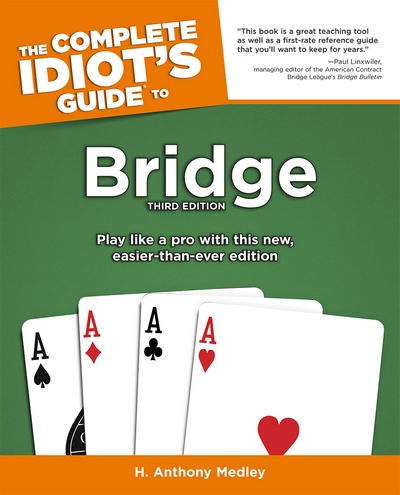| The first and second editions of Complete Idiot's Guide to Bridge by H. Anthony Medley comprised the fastest selling beginning bridge book, going through more than 10 printings. This updated Third Edition includes a detailed Guide to Bids and Responses, along with the most detailed, 12-page Glossary ever published, as well as examples to make learning the game even easier. Click book to order. Available in all bookstores and on Kindle. | ||
|
Enderís Game (7/10) by Tony Medley Runtime 114 minutes. OK for children. This is based on a book by Orson Scott Card written in 1985 before the Iraqi wars that were started by the Presidents Bush against an opponent that had not attacked us and who had no perceptible intent to attack, so Card clearly did not have these specific incidents in mind. But coming as it does after both wars, it seems a stinging rebuke of ďpreventive warsĒ (the first Iraqi war might not have been ďpreventive,Ē but the second certainly was.) Based on a dubious premise, to say the least, the future of the world is put in the hands of one pre-teenager, 12-year-old Ender Wiggins (Asa Butterfield, who gave such a good performance in 2011ís Hugo), to protect the earth against a force that invaded and lost a cataclysmic battle against earth 50 years previous, thanks to an heroic Ben Kingsley. Harrison Ford is a leader who has the task of fighting off a suspected invasion from the same force. Ford is looking for a child who can lead the defense. Apparently the battle will be akin to a video game and the feeling is that the only experts in video games are children who can think and act outside the box. In Cardís book, the children are aged from approximately 6 to 15 and Ender enrolls in the program when heís six. The movie compresses the time to just one year, when heís 12. Trouble is that Asa was 15 when the film was shot; he no more looks like a 12-year-old than I look like Amy Adams; nor does Haile Steinfeld, Enderís good friend, who was 16 when the film was shot. But the worst casting in terms of age is Moises Arias, who is Enderís main antagonist among the cadre of children, who was 18 when the film was shot and looks like a grown man, despite his lack of height. So the point of the film, that the future of the earth is in the hands of pre-pubescent children, is basically destroyed by the casting. The film sort of follows the tenor of Sands of Iwo Jima (1949) in which significantly older John Wayne trains a platoon of young men and readies them for war, and they then fight the war. Crusty Harrison Ford, in Wayneís roll, has the idea to put all these children together so that one emerges as a leader, and one who will be able to fight an unconventional war that will be akin to a video game, at which Ender is an expert, and he targets Ender as that person. Most of the film is putting the children through basic training, not to prepare them for battle, but to choose a leader, which results in Ender having adult-type confrontations and relationships with the others, who also act and react in an adult manner. Writer/director Gavin Hood (whose credits include the outstanding, but little seen, Tsotsi, one of the best films I saw in 2006) gets excellent supporting performances from Viola Davis (as Fordís second in command responsible for the psychological well-being of the children), Ben Kingsley, Steinfeld, Arias, and Abigail Breslin, Enderís sister. The production values, especially the digital cinematography (Donald M. McAlpine), production design (Sean Haworth and Ben Procter), and special effects (Matthew E. Butler) are beautiful and eye-popping. This is yet another movie that pictures advanced aliens, creatures that can conquer space, for heavenís sake, as huge insects who donít even have hands. Where many space alien science fiction movies lack credence is picturing the aliens as creatures whose ability to transcend time and space is not credible because they are inarticulate monsters who look like refugees from Them! (1954) or The Beast from 20,000 Fathoms (1953). Very few picture them as creatures capable of such scientific achievements. The only one that comes readily to mind is The Day the Earth Stood Still (1951) in which Michael Rennie was the alien and he could easily be believed to be of superior intellect, but there may have been a few more. Generally, though, these creatures are pictured as monsters and it strains credulity to the breaking point to believe that these are the types of creatures who can achieve such scientific breakthroughs as space travel. Although to give this film a little credit, Ender figures that the creatures communicate with one another through thought transmission. This has an ending borrowed from science fiction maven Robert Heinlein, and weíve already seen that once before this year in Oblivion. Like the makers of Oblivion the filmmakers donít see fit to give Heinlein any credit. All that said, and even though I got tired of it all, itís an entertaining film. The special effects are terrific, especially the floating around in a gravity-free environment, and thereís a lot of that. Further, if you see this in IMAX, that is worth the price of admission all by itself because the visual is so big and beautiful and clear. October 31, 2013
|
||
